Religious context
Chamunda Devi is considered as the wrathful form of Durga, but at the same time, the Goddess is kind to her true devotees.
The term 'Chamunda' has been derived from two words, 'Chanda' and 'Munda'. As per the mythological legends, Durga made a goddess with her power, to slay the demons, Chanda and Munda. With her immense power, the Goddess killed the demons. Goddess Durga became happy with the slaughter and blessed the goddess that she would be known and worshipped as Chamunda.
In Hinduism, Chamundi, Chamundeshwari and Charchika, is a fearsome aspect of Devi, the Hindu Divine Mother and one of the seven Matrikas (mother goddesses). She is also one of the chief Yoginis, a group of sixty-four or eighty-one Tantric goddesses, who are attendants of Durga. She is closely associated with Kali, another fierce aspect of Devi. She is sometimes identified with goddesses Parvati and Chandi as well. The goddess is often portrayed as haunting cremation grounds or fig trees, and is worshipped by ritual animal sacrifices along with offerings of wine. In the ancient times, human sacrifices were offered, too.
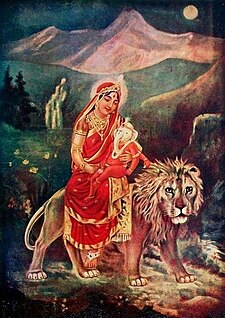
Parvati, Uma or Gauri is the Hindu goddess of power, nourishment, harmony, devotion, and motherhood. She is considered to be Devi in her complete form. She is the principal goddess of Shaivism. She is also one of the central deities of the goddess-oriented sect called Shaktism. Along with Lakshmi and Saraswati, she forms the Tridevi.

Durga is a major deity in Hinduism. She is worshipped as a one of principal aspects of the mother goddess Mahadevi and is one of the most popular and widely revered among Indian divinities. She is associated with protection, strength, motherhood, destruction and wars. According to Devi-Bhagavata Purana she is one of five forms of Goddess Bhuvaneshvari. Her legend centres around combating evils and demonic forces that threaten peace, prosperity, and Dharma the power of good over evil. Durga is believed to unleash her divine wrath against the wicked for the liberation of the oppressed, and entails destruction to empower creation. Historians of religion and art tend to trace the earliest depiction of Durga to the seals of Indus Valley Civilization. However, this claim lacks direct visual evidence from the site. There are several hints to her in the early Vedic texts and by the time of the epics, she emerges as an independent deity. Durga is seen as a motherly figure and often depicted as a beautiful woman, riding a lion or tiger, with many arms each carrying a weapon and often defeating demons. She is widely worshipped by the followers of the goddess centric sect, Shaktism, and has importance in other denominations like Shaivism and Vaishnavism. Under these traditions, Durga is associated and identified with other deities. There are many devotees of Goddess Durga who recite Saptashloki Durga Saptashati to seek her blessings.

Chamunda, also known as Chamundeshwari, Chamundi or Charchika, is a fearsome form of Chandi, the Hindu Divine Mother Durga or Shakthi and is one of the seven Matrikas.
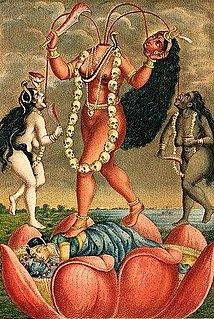
Chhinnamasta, often spelled Chinnamasta, and also called Ch(h)innamastika and Prachanda Chandika and Jogani Maa, is a Hindu goddess (Devi). She is one of the Mahavidyas, ten goddesses from the esoteric tradition of Tantra, and a ferocious aspect of Parvati, the Hindu Mother goddess. The self-decapitated nude goddess, usually standing or seated on a divine copulating couple, holds her own severed head in one hand and a scimitar in another. Three jets of blood spurt out of her bleeding neck and are drunk by her severed head and two attendants.

Shaktism is one of several major Hindu denominations, wherein the metaphysical reality is considered metaphorically a woman and Shakti (Mahadevi) is regarded as the supreme godhead. It includes many goddesses, all considered aspects of the same supreme goddess. Shaktism has different sub-traditions, ranging from those focused on gracious Parvati to that of fierce Kali.

Durga Pooja, also known as Durgotsava or Sharodotsava, is an annual Hindu festival originating in the Indian subcontinent which reveres and pays homage to the Hindu goddess Durga and is also celebrated because of Durga's victory over Mahishasur. It is particularly popular and traditionally celebrated in the Indian states of West Bengal, Bihar, Jharkhand, Odisha, Tripura, Assam and the country of Bangladesh. The festival is observed in the Indian calendar month of Ashwin, which corresponds to September–October in the Gregorian calendar. Durga Puja, is a ten-day festival, of which the last five are of the most significance. The puja is performed in homes and public, the latter featuring a temporary stage and structural decorations. The festival is also marked by scripture recitations, performance arts, revelry, gift-giving, family visits, feasting, and public processions. Durga puja is an important festival in the Shaktism tradition of Hinduism. Durga puja in Kolkata has been inscribed on the Intangible cultural heritage list of UNESCO in December, 2021.
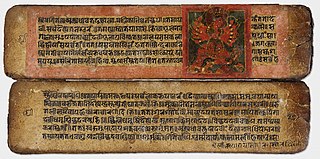
The Devi Mahatmya or Devi Mahatmyam is a Hindu philosophical text describing the Goddess as the supreme power and creator of the universe. It is part of the Markandeya Purana.

Chandi or Chandika is a Hindu deity. Chandika is another form of Mahadevi, similar to Durga. Chandika is a powerful form of Mahadevi who manifested to destroy evil. She is also known as Kaushiki, Katyayani, Asthadasabuja Mahalakshmi, Mahisasuramardini.

Bhadrakālī is a Hindu goddess popular in Southern India, especially in Kerala. She is one of the fierce forms of the Great Goddess Shakti or Adi Parashakti mentioned in the Devi Mahatmyam. Bhadrakali is a popular form of the Great Goddess, worshipped in Kerala as Bhagavati, Mahakali, Chamunda, Sree Kurumba and Kariam Kali Murti. In Kerala she is seen as the auspicious and fortunate form of Mahakali who protects the good known as Bhadra.
Matrikas also called Matar or Matri, are a group of mother goddesses who are always depicted together in Hinduism. The Matrikas are often depicted in a group of seven, the Saptamatrika(s). However, they are also depicted as a group of eight, the Ashtamatrika(s).

Kali, also known as Dakshina Kālikā, is a Hindu goddess who is considered to be the master of death, time and change. She is also said to be the Parvati, the supreme of all powers, or the ultimate reality.

Varahi is one of the Matrikas, a group of seven mother goddesses in the Hindu religion. With the head of a sow, Varahi is the shakti of Varaha, the boar avatar of the god Vishnu. In Nepal, she is called Barahi.
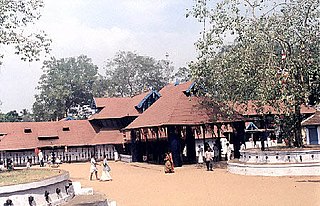
Sree Kurumba Bhagavati Temple is a Hindu temple at Kodungallur, Thrissur District, Kerala state, India. It is dedicated to the goddess Bhadrakali, a form of Maha Kali or Parashakthi worshipped in Kerala. The goddess is known also by the names "Sri Kurumba"" .This temple is the head of 64 Bhadrakali temples in Kerala especially Malabar. This Maha Kali temple is one of the oldest functioning temples in India. This is attested by numerous Tamil poems and inscriptions of different times. The goddess of the temple represents the goddess in her fierce ('ugra') form, facing North, featuring eight hands with various attributes. One is holding the head of the demon king Daruka, another a sickle-shaped sword, next an anklet, another a bell, among others. Routine worship at the temple every day at 03:00 and ends at 21:00 local time.

Navaratri is a biannual Hindu festival that spans over nine nights, first in the month of Chaitra and again in the month of Sharada. It is observed for different reasons and celebrated differently in various parts of the Hindu Indian cultural sphere. Theoretically, there are four seasonal Navaratri. However, in practice, it is the post-monsoon autumn festival called Sharada Navaratri which is the most observed in honour of the divine feminine Devi Durga. The festival is celebrated in the bright half of the Hindu calendar month Ashvin, which typically falls in the Gregorian months of September and October.

Kali Puja, also known as Shyama Puja or Mahanisha Puja, is a festival, originating from the Indian subcontinent, dedicated to the Hindu goddess Kali, celebrated on the new moon day of the Hindu month Kartik especially in the regions of West Bengal, and in Mithila region of Bihar, Odisha, Assam, Tripura, neighbouring country Bangladesh, and the town of Titwala in Maharashtra. Kali Puja is extremely popular in Barasat, Nabadwip, Santipur, Tamluk, Naihati, Barrackpore, Dakshineshwar and Tarapith in West Bengal. Begusarai, Munger, Bhagalpur in Bihar. Guwahati in Assam, Udaipur in Tripura, Ganjam in Odisha, Dhaka and Chittagong in neighbouring country of Bangladesh. It coincides with the Lakshmi Puja day of Diwali. While the Hindu Bengalis, Odias, Assamese and Maithils worship the goddess Kali on this day, the rest of India and Nepal worships goddess Lakshmi on Diwali.

Kalaratri is the seventh of the nine forms of the Goddess Parvati, known as the Navadurga. She is first referenced in the Durga Saptashati, Chapters 81-93 of the Markandeya Purana, the earliest known literature on the Goddess Durga. Kalaratri is widely regarded as one of the many destructive forms of the Mother Goddess, which include Kali, Mahakali, Bhadrakali, Bhairavi, Mrityu, Rudrani, Chamunda, Chandi and Durga.
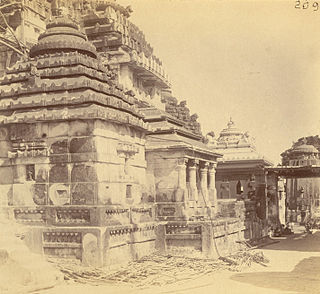
The Vimala Temple or Bimala Temple is a Hindu temple dedicated to goddess Vimala (Bimala), located within the Jagannath Temple complex in Puri in the Indian state of Odisha. It is generally regarded as a Shakti Pitha, among the holiest temples dedicated to the Hindu Goddess.

Aadi Himani Chamunda is a Hindu temple dedicated to Shri Chamunda Devi, situated in Chandar Bhan, Jia in Kangra Valley, Himachal Pradesh, India, in the Himalayas.

Mridanga Saileswari Temple is a famous Hindu temple located in Muzhakunnu, Kannur district, Kerala, India. It is one among the 108 Durga temples of ancient Kerala, believed to have been installed by Parashurama, the sixth avatar of Lord Vishnu. The main deity, Mridanga Saileswari, is a four-armed Durga holding conch and discus in the two hands pointed upwards, blessing her devotees with the front right hand and placing her front left hand on her waist.

















